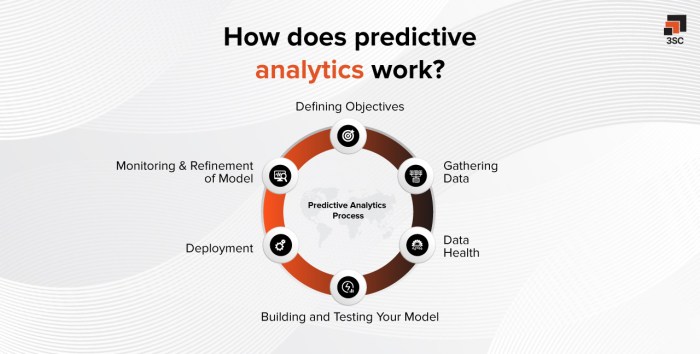The Challenges of Financial Reporting in the Age of Cybersecurity Threats are rapidly evolving, demanding a robust and adaptable approach from organizations worldwide. The increasing sophistication of cyberattacks, coupled with the growing reliance on digital systems for financial operations, presents significant risks to the accuracy, reliability, and integrity of financial reporting. This necessitates a comprehensive understanding of the multifaceted challenges posed by these threats and the implementation of proactive measures to mitigate them. Failure to address these challenges can result in substantial financial losses, reputational damage, and legal repercussions.
This exploration delves into the key aspects of this critical issue, examining the impact of data breaches, the role of internal controls and technology, the responsibilities of external auditors, and the implications of regulatory compliance. We will analyze the human element in cybersecurity vulnerabilities and explore strategies for enhancing security and transparency in financial reporting practices.
Data Breaches and Financial Reporting Integrity
Data breaches pose a significant threat to the accuracy and reliability of financial statements, potentially leading to serious regulatory and legal consequences. The unauthorized access and manipulation of sensitive financial data can distort the true picture of a company’s financial health, impacting investor confidence and market stability. This section explores the multifaceted impact of data breaches on financial reporting integrity.
The impact of data breaches on the accuracy and reliability of financial statements is substantial. Compromised data can be altered, deleted, or misused, leading to inaccuracies in revenue recognition, expense reporting, asset valuation, and liability calculations. This manipulation can result in misstated financial statements, providing a misleading representation of the company’s financial position and performance. Such inaccuracies can range from minor discrepancies to complete fabrication of financial data, depending on the scale and nature of the breach.
Learn about more about the process of Payroll Compliance Checklist for Small Businesses in the field.
Unauthorized Access and Misreporting
Unauthorized access to sensitive financial data, such as customer payment information, accounts payable and receivable records, and internal financial models, directly facilitates misreporting. Hackers might alter transaction records to conceal fraudulent activities, inflate revenue figures, or underreport expenses. Furthermore, the theft of intellectual property, such as proprietary algorithms or pricing models, can lead to significant financial losses that are difficult to accurately quantify and report. This lack of transparency further erodes the integrity of the financial reporting process.
Regulatory and Legal Consequences of Unreported Data Breaches
Failing to report data breaches impacting financial information can result in severe penalties. Regulations like the Sarbanes-Oxley Act (SOX) and the General Data Protection Regulation (GDPR) mandate timely disclosure of security incidents. Non-compliance can lead to hefty fines, legal action from affected parties, reputational damage, and even criminal charges against responsible individuals within the organization. The severity of the consequences depends on factors such as the nature of the breach, the volume of compromised data, the response time of the organization, and the extent of the resulting harm.
Examples of Fraudulent Activities Facilitated by Cybersecurity Breaches
Several real-world examples illustrate the link between cybersecurity breaches and fraudulent financial reporting. For instance, a company might experience a ransomware attack that encrypts its financial data, demanding a ransom for its release. If the ransom is not paid, the company might be forced to estimate its financial losses, leading to inaccuracies in its reporting. Alternatively, a phishing scam targeting employees could grant hackers access to accounting systems, allowing them to manipulate financial records for personal gain or to benefit external parties. In other cases, insider threats, where employees collude with external actors, can result in sophisticated schemes to misappropriate funds and conceal the activity through manipulated financial records.
Impact of Different Data Breach Types on Financial Reporting
The following table compares the impact of different types of data breaches on financial reporting:
| Type of Data Breach | Impact on Financial Reporting | Example | Potential Consequences |
|---|---|---|---|
| Ransomware | Disruption of operations, inability to access financial data, potential for inaccurate estimations of losses | A hospital system is hit with ransomware, preventing access to billing and patient records, leading to delayed and inaccurate financial reporting. | Significant financial losses, regulatory fines, reputational damage |
| Phishing | Unauthorized access to financial systems, manipulation of financial data, fraudulent transactions | An employee clicks a phishing link, granting hackers access to the company’s accounting software, enabling them to alter transaction records. | Financial losses, legal action from affected parties, reputational damage |
| SQL Injection | Data alteration or theft, compromising the integrity of financial databases | Hackers exploit a vulnerability in a company’s website to gain access to its database, altering financial records to conceal embezzlement. | Financial losses, legal action, regulatory fines |
| Insider Threat | Manipulation of financial data, fraudulent transactions, theft of assets | A disgruntled employee alters financial records to conceal embezzlement, impacting the accuracy of the company’s financial statements. | Significant financial losses, criminal charges, reputational damage |
Internal Controls and Cybersecurity in Financial Reporting

Robust internal controls are the bedrock of reliable financial reporting, especially in the face of escalating cybersecurity threats. A strong internal control system acts as a multi-layered defense, mitigating risks and ensuring the accuracy and integrity of financial data. Without such a system, organizations leave themselves vulnerable to data breaches, fraud, and reputational damage, ultimately impacting the credibility of their financial statements.
The Role of Internal Controls in Mitigating Cybersecurity Risks
Effective internal controls significantly reduce the likelihood and impact of cybersecurity incidents affecting financial reporting. These controls encompass a range of measures, from access restrictions and data encryption to regular security audits and incident response plans. A well-designed system ensures that only authorized personnel can access sensitive financial information, and that all data transmissions are secure. Furthermore, robust controls help detect and respond to potential threats in a timely manner, minimizing any disruption to financial reporting processes. For example, implementing multi-factor authentication prevents unauthorized access even if passwords are compromised. Regular security audits identify vulnerabilities before they can be exploited, while incident response plans Artikel clear procedures for handling security breaches, limiting the damage and ensuring business continuity.
Cybersecurity Awareness Training for Finance Professionals
Comprehensive cybersecurity awareness training is paramount for finance professionals. Employees often represent the weakest link in an organization’s security chain. Training programs should cover topics such as phishing scams, malware, social engineering tactics, and safe password practices. Regular refresher courses are essential to reinforce good security habits and keep employees updated on the latest threats. For example, a well-designed training program might include interactive modules simulating phishing attacks, allowing employees to practice identifying and reporting suspicious emails. This proactive approach minimizes the risk of human error, a leading cause of data breaches.
Key Cybersecurity Controls for Protecting Financial Data and Systems
Several key cybersecurity controls are crucial for protecting financial data and systems. These include: data encryption (both in transit and at rest), access control mechanisms (limiting access based on the principle of least privilege), regular security audits and penetration testing, intrusion detection and prevention systems, and robust backup and disaster recovery plans. Furthermore, implementing a strong security information and event management (SIEM) system enables organizations to monitor security events, detect anomalies, and respond swiftly to threats. The use of strong, unique passwords, coupled with multi-factor authentication, adds an extra layer of protection. Finally, regular software updates and patching are essential to close security vulnerabilities.
Framework for Evaluating Internal Control Effectiveness
A structured framework is needed to evaluate the effectiveness of existing internal controls in preventing cybersecurity threats to financial reporting. This framework should incorporate a risk assessment process to identify potential vulnerabilities, a control testing methodology to assess the design and operating effectiveness of controls, and a reporting mechanism to communicate findings and recommendations to management. The evaluation should cover all aspects of the financial reporting process, from data collection and processing to reporting and disclosure. A key element of this framework is the use of a standardized questionnaire to assess the maturity of controls across various dimensions, enabling a comprehensive evaluation of the organization’s overall cybersecurity posture. The results of this evaluation should then inform a remediation plan to address identified weaknesses.
Best Practices for Securing Financial Data During Financial Reporting
Securing financial data during the financial reporting process demands adherence to best practices. This includes implementing strict access controls, encrypting sensitive data both in transit and at rest, regularly backing up data to secure offsite locations, and utilizing secure communication channels. Furthermore, organizations should adopt a robust change management process to minimize the risk of unintended consequences from system updates or modifications. The segregation of duties is also vital, ensuring that no single individual has complete control over the financial reporting process. Regular reconciliation of financial data is also crucial for detecting anomalies and potential errors. Finally, organizations should develop and regularly test their incident response plan to ensure a swift and effective response to any security breach.
The Role of Technology in Enhancing Cybersecurity for Financial Reporting
The increasing sophistication of cyber threats necessitates a proactive approach to safeguarding financial reporting integrity. Technology plays a crucial role in bolstering cybersecurity defenses, offering innovative solutions to mitigate risks and enhance the reliability of financial information. This section explores several key technological advancements contributing to stronger financial reporting security.
Blockchain Technology and Financial Reporting Security
Blockchain technology, known for its decentralized and immutable ledger system, offers significant potential for enhancing the security and transparency of financial reporting. Each transaction is recorded as a “block” linked cryptographically to the previous block, creating an auditable trail that is resistant to tampering. This enhances transparency by making the entire financial reporting process readily verifiable by authorized parties. Furthermore, the decentralized nature of blockchain reduces the risk of single points of failure, minimizing the impact of potential cyberattacks. For example, a distributed ledger system could record and verify financial transactions across multiple nodes, making it significantly more difficult for malicious actors to alter or delete records. The increased transparency and auditability facilitated by blockchain can lead to greater trust and confidence in the accuracy and reliability of financial reports.
Advanced Encryption Techniques and Data Protection
Advanced encryption techniques, such as AES-256 and RSA, are essential for protecting sensitive financial data. These methods utilize complex algorithms to transform readable data (plaintext) into an unreadable format (ciphertext), making it virtually impossible for unauthorized individuals to access the information without the appropriate decryption key. However, the effectiveness of encryption depends heavily on the implementation and management of the encryption keys. Weak key management practices can render even the strongest encryption algorithms vulnerable. Additionally, the computational resources required for advanced encryption can be significant, potentially impacting system performance. Despite these limitations, advanced encryption remains a cornerstone of cybersecurity for financial reporting, safeguarding sensitive information both in transit and at rest.
Artificial Intelligence and Machine Learning in Threat Detection
Artificial intelligence (AI) and machine learning (ML) are rapidly transforming cybersecurity practices, offering powerful tools for detecting and preventing cyber threats to financial reporting. AI and ML algorithms can analyze vast amounts of data to identify anomalies and patterns indicative of malicious activity. These algorithms can learn from past attacks to predict future threats and proactively mitigate risks. For instance, AI-powered systems can detect unusual login attempts, suspicious network traffic, and anomalies in financial transactions, alerting security personnel to potential breaches in real-time. Machine learning models can also be trained to recognize specific types of malware and phishing attacks, enabling faster and more effective responses to security incidents. The proactive nature of AI and ML-based security systems is a significant advantage in the face of constantly evolving cyber threats.
Cloud-Based Solutions and Enhanced Security
Cloud-based solutions offer several advantages in terms of enhancing the security of financial data and systems. Cloud providers typically invest heavily in robust security infrastructure and expertise, providing organizations with access to advanced security technologies that may be cost-prohibitive to implement in-house. Features such as data encryption at rest and in transit, multi-factor authentication, and intrusion detection systems are commonly offered by cloud providers. Furthermore, cloud-based solutions often provide greater scalability and flexibility, allowing organizations to adapt their security posture as their needs evolve. For example, a company can easily scale its cloud-based infrastructure to handle increased data volumes during peak periods, ensuring that security measures remain effective even under pressure. However, it’s crucial to carefully select a reputable cloud provider with a strong security track record and to ensure compliance with relevant regulations.
Emerging Technologies for Strengthening Cybersecurity, The Challenges of Financial Reporting in the Age of Cybersecurity Threats
Several emerging technologies promise to further strengthen cybersecurity in financial reporting. These include:
- Quantum-resistant cryptography: Preparing for the potential threat of quantum computing, which could break current encryption algorithms.
- Zero trust security: Implementing a security model that assumes no implicit trust and verifies every access request.
- Extended Detection and Response (XDR): Integrating security tools across various platforms to provide a unified view of security threats.
- Blockchain-based identity management: Using blockchain to securely manage and verify user identities.
These technologies represent the forefront of cybersecurity innovation, offering enhanced protection against increasingly sophisticated threats to financial reporting integrity. The continuous adoption and refinement of these technologies are crucial for maintaining the reliability and security of financial information in the digital age.
External Audits and Cybersecurity Considerations
The increasing reliance on technology in financial reporting has significantly amplified the importance of cybersecurity in the external audit process. Auditors are no longer solely focused on traditional financial controls; they must now consider the potential impact of cyber threats on the reliability and integrity of financial information. This necessitates a broader understanding of cybersecurity risks and the implementation of effective controls to mitigate them.
Auditors’ responsibilities are evolving to encompass a comprehensive assessment of an organization’s cybersecurity posture and its implications for financial reporting. This requires a multi-faceted approach, encompassing the evaluation of both preventative and detective controls, and a thorough understanding of the organization’s technology infrastructure and data security practices. Failure to adequately address cybersecurity risks can lead to material misstatements in financial statements, reputational damage, and legal repercussions for both the audited entity and the auditing firm.
The Expanding Role of External Auditors in Cybersecurity Risk Assessment
External auditors are increasingly expected to possess a fundamental understanding of cybersecurity risks and their potential impact on the financial reporting process. This involves assessing the likelihood and potential impact of various cyber threats, such as data breaches, ransomware attacks, and denial-of-service attacks. Auditors must evaluate the adequacy of the entity’s cybersecurity controls and their effectiveness in mitigating these risks. This assessment should include a review of the organization’s cybersecurity policies, procedures, and technologies, as well as an evaluation of the competence and awareness of personnel responsible for cybersecurity. The audit should consider the organization’s vulnerability management processes, incident response plans, and business continuity strategies. The increasing sophistication of cyberattacks necessitates a more proactive and risk-based approach to audit planning and execution.
Verifying the Effectiveness of Internal Controls Related to Cybersecurity
Auditors employ various techniques to verify the effectiveness of internal controls designed to mitigate cybersecurity threats. These techniques include walkthroughs of key controls, testing of access controls, review of system logs and audit trails, and assessment of vulnerability scanning and penetration testing results. The auditor will examine evidence demonstrating the organization’s adherence to established security policies and procedures. For example, they may review evidence of regular security awareness training for employees, evidence of vulnerability patching, and evidence of regular penetration testing and vulnerability scanning. The auditor’s objective is to gain reasonable assurance that the controls are operating effectively and are designed to prevent or detect material misstatements resulting from cybersecurity incidents. The use of data analytics techniques can also enhance the efficiency and effectiveness of this process.
Challenges in Obtaining Sufficient Audit Evidence Related to Cybersecurity
Obtaining sufficient and appropriate audit evidence related to cybersecurity presents significant challenges for auditors. The complexity of IT systems, the rapidly evolving nature of cyber threats, and the lack of standardized cybersecurity frameworks can make it difficult to assess the effectiveness of controls. Further challenges include the limitations of testing, the reliance on management representations, and the difficulty in accessing and interpreting complex technical information. The ephemeral nature of some cyber threats and the potential for sophisticated attackers to cover their tracks further complicate the audit process. Auditors may also face challenges in obtaining sufficient expertise in cybersecurity to conduct effective audits.
Communicating Cybersecurity Risks to Audit Committees and Management
Effective communication of cybersecurity risks to audit committees and management is crucial. Auditors should clearly articulate the identified risks, their potential impact on financial reporting, and the effectiveness of the entity’s controls in mitigating those risks. This communication should be tailored to the audience’s level of understanding and should include specific recommendations for improvement. The use of clear and concise language, supported by visual aids and illustrative examples, can enhance the effectiveness of communication. Regular updates on the cybersecurity risk landscape and the organization’s response to emerging threats are also important. The communication should also clearly Artikel the limitations of the audit procedures performed and any unresolved issues.
Cybersecurity Considerations Checklist for External Auditors
The following checklist highlights key cybersecurity considerations for external auditors during financial statement audits. This is not exhaustive but serves as a starting point for a comprehensive assessment.
- Assess the organization’s cybersecurity risk profile, including the likelihood and potential impact of various cyber threats.
- Review the organization’s cybersecurity policies, procedures, and technologies.
- Evaluate the effectiveness of key controls, such as access controls, change management, and incident response procedures.
- Examine evidence of regular security awareness training for employees.
- Review vulnerability scanning and penetration testing results.
- Assess the organization’s data backup and recovery procedures.
- Evaluate the organization’s business continuity and disaster recovery plans.
- Consider the impact of cloud computing and other emerging technologies on cybersecurity risk.
- Document the audit procedures performed and the results obtained.
- Communicate cybersecurity risks and recommendations to the audit committee and management.
Regulatory Compliance and Cybersecurity in Financial Reporting

The increasing interconnectedness of financial systems and the proliferation of cyber threats have significantly heightened the importance of regulatory compliance in maintaining the integrity of financial reporting. Evolving regulatory frameworks worldwide are forcing organizations to bolster their cybersecurity defenses and implement robust data protection measures to safeguard sensitive financial information. Failure to comply can result in substantial financial penalties and reputational damage.
The impact of evolving regulatory frameworks such as the General Data Protection Regulation (GDPR) in Europe and the California Consumer Privacy Act (CCPA) in the United States, significantly shapes cybersecurity practices within financial reporting. These regulations mandate specific data protection measures, including data breach notification requirements, consent management protocols, and stringent data security standards. Compliance necessitates a proactive approach to risk management, encompassing regular security assessments, employee training, and the implementation of advanced security technologies.
Penalties and Sanctions for Non-Compliance
Non-compliance with cybersecurity regulations related to financial reporting can lead to severe consequences. Financial penalties can range from substantial fines – potentially reaching millions of dollars depending on the severity of the violation and the volume of data compromised – to legal action from affected individuals and regulatory bodies. Beyond financial repercussions, reputational damage can severely impact an organization’s credibility and customer trust, leading to loss of business and market share. In extreme cases, regulatory bodies may impose operational restrictions or even revoke licenses, effectively shutting down the business. For example, the GDPR allows for fines up to €20 million or 4% of annual global turnover, whichever is higher, for serious breaches.
Key Regulatory Requirements Related to Data Protection and Cybersecurity
Several key regulatory requirements govern data protection and cybersecurity in the financial services industry. These typically include mandates for data encryption, both in transit and at rest; robust access control measures to limit access to sensitive data to authorized personnel only; regular security audits and vulnerability assessments to identify and address potential weaknesses; incident response plans to effectively manage and mitigate the impact of data breaches; and employee training programs to raise awareness of cybersecurity risks and best practices. Many jurisdictions also require organizations to implement data breach notification procedures, requiring them to inform affected individuals and regulatory bodies within a specified timeframe following a data breach.
Comparison of Cybersecurity Regulations Across Financial Institutions
Cybersecurity regulations vary depending on the type of financial institution. Banks and other credit institutions, for instance, are often subject to more stringent regulations due to the sensitive nature of the financial data they handle and the potential systemic impact of a breach. Insurance companies face regulations focused on protecting customer data and ensuring the confidentiality of policy information. Investment firms are subject to regulations safeguarding client assets and preventing market manipulation through cyberattacks. These differences reflect the varying levels of risk associated with different financial services and the potential impact of cybersecurity failures. For instance, regulations like the Gramm-Leech-Bliley Act (GLBA) in the US specifically target financial institutions, requiring them to protect customer data.
Compliance Strategies for Cybersecurity Regulations
Organizations can achieve compliance through a multi-faceted approach. This involves conducting regular risk assessments to identify vulnerabilities and prioritize mitigation efforts; implementing robust security controls, such as firewalls, intrusion detection systems, and data loss prevention (DLP) tools; establishing a comprehensive incident response plan that Artikels procedures for handling security incidents; providing ongoing security awareness training to employees to prevent human error, a major source of breaches; and regularly auditing security controls to ensure their effectiveness. Furthermore, maintaining detailed records of security measures and incident responses is crucial for demonstrating compliance to regulatory bodies during audits. Adopting a framework like NIST Cybersecurity Framework can provide a structured approach to implementing and managing cybersecurity controls.
The Human Factor in Cybersecurity Threats to Financial Reporting
The human element represents a significant vulnerability in the cybersecurity landscape of financial reporting. Despite robust technological safeguards, human error and susceptibility to social engineering remain primary vectors for data breaches and compromised financial integrity. Understanding these vulnerabilities and implementing effective mitigation strategies is crucial for maintaining the reliability and trustworthiness of financial reporting.
Human error plays a considerable role in creating vulnerabilities within financial reporting systems. Negligence, such as failing to update software or using weak passwords, can leave systems open to exploitation. Similarly, a lack of awareness regarding phishing attempts or other social engineering tactics can lead to accidental compromise of sensitive data. These errors, often unintentional, can have significant consequences for the accuracy and reliability of financial reporting.
Social Engineering Attacks and Financial Data Compromise
Social engineering attacks exploit human psychology to manipulate individuals into divulging confidential information or performing actions that compromise security. These attacks often target finance professionals, leveraging their trust and expertise to gain access to sensitive financial data. Methods include phishing emails disguised as legitimate communications from trusted sources, pretexting where attackers fabricate a scenario to gain access, or baiting, which involves offering something enticing in exchange for information. Successful social engineering attacks can lead to significant financial losses, reputational damage, and regulatory penalties.
Employee Training and Awareness Programs in Cybersecurity
Comprehensive employee training and awareness programs are essential for mitigating the risks associated with human error in cybersecurity. These programs should educate employees on various threats, including phishing, malware, and social engineering tactics. Training should also cover secure password practices, data handling procedures, and the importance of reporting suspicious activity promptly. Regular refresher courses and simulated phishing exercises can reinforce learning and improve employee vigilance. The investment in robust training pays off significantly by reducing the likelihood of successful attacks and limiting the impact of those that do occur.
Examples of Phishing Scams Targeting Finance Professionals
Phishing scams targeting finance professionals often mimic legitimate communications from banks, financial institutions, or regulatory bodies. These emails may contain urgent requests for sensitive information, such as login credentials, account numbers, or wire transfer details. For example, an email might claim that a suspicious transaction has been detected on the employee’s account, urging them to click a link to verify their details. This link, however, could lead to a malicious website designed to steal credentials. Another example could involve a seemingly legitimate invoice requesting immediate payment, leading to a fraudulent transfer. The consequences of such scams can range from minor data breaches to substantial financial losses and reputational harm.
Visual Representation of Human Errors Leading to Cybersecurity Breaches
Imagine a diagram showing a central node representing a financial reporting system. Branching out from this node are several pathways representing different types of human errors. One pathway shows a figure clicking on a suspicious email link (phishing), another shows a figure using a weak password (password negligence), a third depicts a figure failing to update software (software vulnerability), and a final pathway shows a figure leaving sensitive documents unattended (physical security failure). Each pathway leads to a final node representing a data breach or system compromise. The diagram visually emphasizes the multiple points of vulnerability introduced by human error, highlighting the interconnectedness of these errors and their cumulative effect on overall system security.
Ending Remarks: The Challenges Of Financial Reporting In The Age Of Cybersecurity Threats
In conclusion, navigating the complex landscape of cybersecurity threats in the context of financial reporting requires a multi-pronged approach. Robust internal controls, advanced technologies, and a strong emphasis on employee training and awareness are crucial components of a comprehensive security strategy. Furthermore, close collaboration between organizations, auditors, and regulators is essential to ensure the integrity and reliability of financial information in an increasingly digital world. By proactively addressing these challenges, organizations can safeguard their financial interests, maintain their reputation, and comply with evolving regulatory requirements.
FAQ Corner
What are the most common types of cyberattacks targeting financial reporting?
Common attacks include phishing, ransomware, malware, and denial-of-service attacks, all aiming to disrupt operations, steal data, or extort funds.
How can companies demonstrate compliance with cybersecurity regulations related to financial reporting?
Demonstrating compliance involves implementing robust security measures, maintaining detailed documentation of security policies and procedures, conducting regular audits and assessments, and promptly reporting any security incidents.
What is the role of insurance in mitigating cybersecurity risks related to financial reporting?
Cybersecurity insurance can help cover costs associated with data breaches, including legal fees, regulatory fines, and remediation efforts. It’s a crucial aspect of risk management.
What are the long-term consequences of a significant data breach impacting financial reporting?
Long-term consequences can include lasting reputational damage, loss of investor confidence, difficulty securing loans, and increased regulatory scrutiny.








